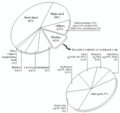Why "Brain Gyms" May Be The Next Big Business
by: fast company, 2011-06-16 18:15:02 UTC
Four years ago, investors gingerly handed over seed money to Lumosity, a startup creating brain games. Today they're happily tossing the same company $32 million. What changed?

Back in 2007, Lumosity was a scrappy startup scrounging for seed money. Today, the San Francisco-based company that creates games to make your brain work better is announcing it’s landed over $32 million in new funding.
What a difference four years make.
“When we first invested, we were concerned this was just a niche area for people with Alzheimer’s or other cognitive problems,” Tim Chang of Norwest Venture Partners tells Fast Company. “But Lumosity has proved there’s universal demand for this among all demographics.”
Indeed, today, over 14 million people in 180 countries either subscribe to Lumosity’s website or have downloaded one of its iPhone apps. And revenues have grown 25% every quarter since its launch.
Other companies, like CogniFit and Posit Science, also compete in this space, though none has received as large a round of funding as Lumosity. Sharp Brains, a market research firm tracking the brain fitness space, estimates that the size of the market for digital products was just under $300 million in 2009 and will grow to at least $2 billion by 2015.
Lumosity’s website offers 40 games designed to sharpen a wide range of cognitive skills. The signup process walks you through a series of questions to figure out whether you want, for example, to improve your ability to remember names, get better at problem solving, or develop better concentration at work or while driving. It then designs a series of “courses” tailored to your particular interests.

In one game, players are given a three-letter prefix and must come up with as many words as possible while a clock counts down. In another, arithmetic problems appear in bubbles, and the player has to solve them before the bubble bursts. A third, which is reminiscent of the IQ tests you took as a kid, challenges you to remember the locations of various tiles in a grid.
But all of this comes at a price. Website subscriptions cost $14.95 a month, or $80 a year. And yet, plenty of people are paying.
Lumosity CEO Kunal Sarkar tells Fast Company that’s in part because brain fitness is the latest wave in the trend of healthy living that started three decades ago when suburbanites started flocking to gyms and continues today with the widespread interest in yoga and organic foods. Many people pony up the annual subscription, equating it with a gym membership, but for their brains.
Meanwhile, the neuroscience research coming out of universities over the past couple of decades has confirmed that cognitive abilities are not necessarily fixed. Just as you can beef up your body by lifting weights, the types of games that Lumosity and its competitors offer can make your brain stronger and work faster and better.
“There’s a growing understanding that you can affect core cognitive functioning throughout your life,” says Sarkar, whose cofounder Michael Scanlon was a neuroscience graduate student at Stanford before he--in good Silicon Valley form--dropped out to help start the company.
The fact that more and more of us work in fields that rely on how well that piece of jelly between our ears functions is also part of what’s driving the interest in brain fitness. Lumosity users include everyone from traders in Chicago who use the tools to warm up their noggins before heading to the trading floor, to actors in Los Angeles wanting to get better at memorizing scripts, to pilots using them to improve their spatial abilities and reaction times.
“We don’t necessarily teach you anything,” Sarkar says, “but we make it easier for you to learn new things, which is more and more important.”
[Image: Flickr user Arend Vermazeren]
E.B. Boyd is FastCompany.com’s Silicon Valley reporter. Twitter. Email.


 Flexible Generators to turn your shoes into rechargeable batteries
Flexible Generators to turn your shoes into rechargeable batteries
by: Ecofriend, 2011-06-16 11:21:38 UTC
Charu Minocha:

Dielectric GeneratorFlexible generator turns shoes into energy source
If you think shoes are only limited to being showcased as an accessory, think twice! The shoes that you wear can also act as an energy producing device. The bioengineers at the University of Auckland have incepted an innovative concept of energy generating clothing and shoes. The bioengineers, with the concept of a lightweight energy generating rubber, have conveniently done away with the idea of heavy weight generators. The rubber energy generator works on the principle of artificial muscle technology and is said to generate a watt of power when slid inside a shoe.
Thomas Mckay, a Ph.D. student researching on soft generator, seeks to explain about the artificial muscle technology here. It can be described as a stretchable material. When deformed, this material is devised to produce energy. The feature that distinguishes artificial muscle from traditional piezo-electric generators is that the former is designed to work with ‘large, slow motions’.
On the other hand, the latter requires fast and delicate movements to work. The large slow motions that the artificial muscle requires, can be easily produced with daily activities. Another benefit of employing artificial muscles as energy generators is that they do not require any external circuit to get them to function.
McKay is known to develop a high powered model of an artificial muscle. It measures four inches in width and can generate up to 10 mill
watts of power. Fitted in a Perspex frame, the design incorporates rubber membranes and carbon grease. The design qualified as highly beneficial not only for the amount of power it generated for its given size but also for the fact that its size allowed for slipping it inside a shoe or conveniently folding it up in a garment. To add to the platter of benefits, the design was priced at a mere $4.
Via: Ecouterre


 Everything I need to know about transparent solar panels
Everything I need to know about transparent solar panels
by: Ecofriend, 2011-06-16 12:05:54 UTC
Ankita Agarwal:

Transparent Solar panelsClean Power
Solar panels are photovoltaic devices that are being used to transfer heat energy from the Sun to power electronic machineries like calculators, satellites etc since long. And the most recent development in this field are the transparent solar panels. These transparent cells can turn any window pane into solar power generator without obstructing the passage of light. The new cells in the panel are made of organic molecules that absorb energy only from near infra-red light at high efficacy. The absorbed energy is converted into electricity that can be utilized for any purpose. Richard Lunt, one of the researchers believes that some day this project can turn a skyscraper into a large solar power generator.
Trends
1. Sphelar cells are the new ‘power windows’

Sphelar solar technologyDeveloped by Kyosemi Corporation
Kyosemi Corporation of Japan developed spherical micro solar cells named Sphelar. It is made from solidified silicon drops reduced to a size of 1.8 mm in diameter.The spherical shape enhances the absorption of light from all angles and makes it very efficient and flexible for power generation. It is highly transparent and so can be embedded into any glass to make a transparent solar cell window.
2.Konarka develops transparent solar cells for energy harvesting windows

Konarka solar cell technologyTransparent BIPV
Konarka Technologies Inc., Massachuesetts has developed transparent solar cells from flexible plastic. The company has made prototypes of BIPV( building integrated photovoltaics) windows with the solar cells sandwiched between two glass panes. Konarka has signed an agreement with Arch Aluminium And Glass to use these cells in building material. You don’t need to compromise with the aesthetics of your home as the windows are transparent and can also be tinted with color.
3. Chin Hua Solar Glass

BIPVTransparent solar windows
Chin Hua Solar Glass is a Chinese innovation that generates electricity from transparent solar panel. At Taipei’s International Week of Optoelectronics, electricity was being made from this slightly foggy Chin Hua solar window. The haziness of the window can be increased to up the efficiency of production of electricity. This solar glass can also be incorporated into cars to produce electricity for an electric car.
4.Transparent solar windows based on dyes

Solar EnergyTransparent solar windows
Queensland University of Technology is working with Dyesol to produce solar cells that can transform windows into energy providers. Dyesol works on the technology of artificial photosynthesis where dye absorbs sunlight to generate electricity. The panel is composed of an electrolyte i.e. titania and ruthenium dye, which is sandwiched between glasses. The light strikes the dye which excites an electron and is absorbed by titania to produce current.
Benefits
The sun is a wonderful natural resource that can cater to all our energy needs. The harnessing of sunlight through transparent solar panels generates electricity without impeding the light passage. It is not only eco-friendly but also cost effective. An office building with transparent solar windows can produce electricity which is enough to fulfill its requirements. It comes in all kinds of shapes and sizes and can also be tinted with colors. Using the window as surface area provides much more solar energy than earlier solar panels.
Limitations
1. Efficiency: The solar cells in transparent solar panels have an efficiency of 2% which is very low as as compared to 12% of conventional solar panels.
2. Lifespan: The biggest challenge is to increase the longevity of the transparent solar panels to match them with the life span of the window.
Impact
If the production of transparent solar panel is proven commercially viable then it will be environmentally and financially very beneficial. The large buildings can cater some of their energy requirements through this. It is not a perfect technology but these innovations open the door for use of renewable energy resources in larger scale in near future.


 Biodegradable Plastics Are Adding to Landfill Methane Emissions
Biodegradable Plastics Are Adding to Landfill Methane Emissions
by: Eco Geek Latest, 2011-06-10 18:03:21 UTC

The merits of biodegradable plastics have been uncertain, but a new study that appears in the journal Environmental Science & Technology says that though these types of plastics aren't littering the ocean or clogging landfills, they are contributing to climate change in the last phase of their life cycle.
When the biodegradable utensils and other plastics get to the landfill, microbes break them down and produce methane, a potent greenhouse gas. While many other items in landfills create methane as well, these plastics are adding to the load. Some landfills have systems that capture the methane and use it for energy, but most landfills don't.
So while these plastics are free of petroleum and biodegrade instead of existing forever, their life-cycle impact isn't negligible. Is it still better than the regular plastic disposables? Yes, but this just further illustrates that it's best to skip disposable utensils and cups and go for the reusable stuff.
via Scientific American
 Catalytic Clothing by Helen Storey and Tony Ryan
Catalytic Clothing by Helen Storey and Tony Ryan
by: Dezeen, 2011-06-15 17:30:58 UTC

This movie by Adam Mufti features supermodel Erin O’Connor wearing a dress that incorporates a catalytic converter. This is the first part of a collaboration between designer Helen Storey and chemist Tony Ryan to create clothes that filter pollution from the air. Music is by Radiohead. Watch the movie on Dezeen Screen. (more…)


 SafetyNet by Dan Watson
SafetyNet by Dan Watson
by: Dezeen, 2011-06-16 09:13:36 UTC

Royal College of Art student Dan Watson has designed a trawling net that filters young and endangered fish from the catch. (more…)


 Sustainable Style and Design Marketplace "Salt and Ethic" Launches in Spain (Video)
Sustainable Style and Design Marketplace "Salt and Ethic" Launches in Spain (Video)
by: TreeHugger Design, 2011-06-16 14:45:24 UTC
 "Charlotte Dress" by Love Me Again. Photo: Salt and Ethic
"Charlotte Dress" by Love Me Again. Photo: Salt and Ethic
Does sustainable design and style have a place in pop culture?
Salt and Ethic thinks so.
Founded on the belief that "only design and style will be able to introduce responsible consumption into pop culture," the new online marketplace connects people around the world with designers in Barcelona, London, Paris, Stockholm, Sao Paulo, Milano, Berlin, and more. Watch the video:
...
Read the full story on TreeHugger
Book Review: A Taxonomy of Office Chairs, by Jonathan Olivares
by: Core77, 2011-06-14 18:00:00 UTC

Our first introduction to the taxonomy of chairs by Jonathan Olivares was at the Phaidon Store on Wooster where a meticulously deconstructed chair hangs suspended in an exploded view of it's requisite parts in the window. The armrest, the back, the seat and the base all float away from the chair in a deconstruction of a chair, an appropriate metaphor for Olivares's Taxonomy.
In the introduction, he explains that natural objects have been the subject of taxonomy since man first tried to understand his environment. An early page shows the morphology of the leaves from Carolus Linnaeus' Hortus Cliffortianus, or if you're a baller, the real book and after a quote from Baudrillard's The System of Objects, Olivares goes on to explain that, "As far as [he] knows, this book is the first taxonomy of an industrialized object." It could have been the taxonomy of toasters or automotive engines, but office chairs seemed an ideal subject because of their close relationship with the human body and their mechanical complexity. Wow!
While car aficionados, trainspotters or objectophiles in general tend to have a highly detailed and hugely comprehensive mental library of specialty-related ephemeral otaku-like traits, that knowledge is rarely categorical. That is to say that while they might be able to distinguish a Corvette from a Corvair and explain the historical relevance of each, no one as of yet has ever tracked the "evolution" of a thing and categorized it based upon the classification on novel traits alone. For that reason alone, the Taxonomy of Office Chairs is a milestone of wonderment to us, precisely because a non-designer would likely find it soporific, just as I would upon hear someone rattle off baseball batting averages.


(more...)


 Power-Generating Artificial Leaf Moves Closer to Reality
Power-Generating Artificial Leaf Moves Closer to Reality
by: fast company, 2011-06-13 22:39:17 UTC
Mimicking the highly efficient power-generation process of photosynthesis, an artificial leaf could change how the world gets energy. And new developments at MIT mean it could happen in the next few years.

Earlier this year, MIT professor Daniel Nocera made a discovery: By dipping a cobalt-and phosphate-coated artificial silicon leaf into a jar of water, he could effectively mimic photosynthesis and create power at an efficiency greater than today's
solar panels. Now two separate teams of MIT researchers have figured out how to combine a standard silicon solar cell with Nocera's cobalt phosphate catalyst--meaning a cheap, simple, artificial leaf is one step closer to reality.
In Nocera's vision of a photosynthesis-mimicking artificial leaf, a water-filled glass container would feature a solar cell with cobalt phosphate catalysts on both sides. The cell would be attached to a divider that separates the container into two sections. Upon exposure to the sun, the catalysts would generate hydrogen and oxygen bubble streams that could be combined to generate electricity.
Both teams of researchers have managed to produce functioning devices, but there is still plenty of work to be done to make sure that the device could continue performing for longer than a few days:
Rajeshwar Krishnan,
Distinguished University Professor of Chemistry and Biochemistry at the
University of Texas at Arlington, says it remains to be seen "whether
this 'self-healing' catalyst would hold up to several hours of current
flow … under rather harsh oxidative conditions." But he adds that these
papers "certainly move the science forward."
Nocera anticipates that the artificial leaf system will be ready in three years. In the meantime, Nocera and his company Sun Catalytix are working on a first-generation system featuring cobalt phosphate catalysts connected via wire to conventional solar cells. And eventually, a more advanced (and reasonably priced) artificial leaf could be sold to the billions of people who lack access to the electrical grid, but have plenty of access to the sun.
[Image: Flickr user fbaett]
Reach Ariel Schwartz via Twitter or email.


 What's next: Human-powered battery chargers
What's next: Human-powered battery chargers
by: Ecofriend, 2011-06-14 04:44:20 UTC
Munmun Goswami:

hand grip chargerhand grip charger-hand grip charger.
As we know it
Energy is becoming a scarce resource, especially when it is a non-renewable one. Resources like wind, water and solar energy are being increasingly harnessed for power. Countries around the world are participating in the green marathon and collectively we have succeeded in reducing the use of fossil fuels.
Need for change
The process of harnessing wind energy and solar energy is largely dependent on the right speculation of the present and the future climatic conditions. The need is definitely to look out for something that can be eternally. Strikingly, that could be our selves! Humans are the most potent forms of energy existing on the earth. It would be a phenomenal achievement if we could use this energy to energise the world around us? This is exactly what is playing around the brain strings of researchers and designers.
What’s next:
1. YoGen human-powered charger

Yogen-human powered chargerEasy Energy has launched a new green charger that doesn’t depend on the climate but lets you charge everything from cellphones to GPS devices using your own energy.
What’s new:
This marvellous palm sized creation by Easy Energy is going to face its first public display at the Hong-Kong Electronics Fair. It can be used to charge all kinds of devices for hey-day use starting from a mobile phone to a GPS device with a fair accuracy.
What difference will it make:
YoGen carries a ripcord, which on being pulled repeatedly would create energy, enough to charge portable electronic items. All it needs to operate is a dedicated pull-release session of a few minutes.
2. iPhone hand grip charger

iPhone hand grip chargerThis iPhone hand grip charger will give you Hulk hands before you even get a full battery.
What’s new:
This grip charger is a bit masculine device favorable for muscle men. Operating the charger would require a good amount work out for your hands. However, the suffering comes with a perk for golfers. The Swing-Charge-and-study grip charger can be used to track the number of swings and the accuracy of swings taken.
What difference will it make:
Nothing much, only that men have a good reason to cheer up. They would not require spending much to woo girls.
3. Orange and Gotwind charger

orange and gotwind chargerOrange developed a solar and wind power solution for an off-the-grid cellphone charger for the Glastonbury Festival.
What’s new:
A consistent participant in the Glastonbury Festival, Orange has now come up with its all new foot-powered cell-phone recharging device in collaboration with Gotwind. The charger works much like an air-pump, the only difference being that air is pumped into a wind turbine generator, rather than into a tire. The wind energy gets converted into electricity.
What difference will it make:
It is a confident claim that 60 pumps, that would take 1 min, will keep a cell charged for 5mins. Considering these figures, the device would serve as an emergency companion.
4. Kineticel

KineticelOne of the ideas submitted to the Next Generation competition featured in Metropolis Magazine was this Kinetic Energy-harnessing battery charger by Yael Miller.
What’s new:
Yeal Miller has presented a novel way to generate electricity – converting kinetic energy into electric energy. This device captures energy released by any movement and uses it.
What difference will it make:
A vary common happening, but yet very novel to conceptualize, this device would actually churn energy out of nothing.
5. Jump for Juice

Jump for juiceThis great design from Jooyong Kim and Sungkyung Kim helps you power your gadgets with green power while improving your physical health.
What’s new:
Ever heard of energy consumption and production at the same time? Well, this device uses this concept. It is basically a jumping rope, which charges the battery, when you jump.
What difference will it make:
Fitness and environment at the same time. It would make you jump to keep your cell jumping.
6. Light Bulb Shaped Human-Powered Charger

Cyclus ChargerSpring driven human-powered concept charger
What’s new:
This necessarily makes use of fidgeting movements that we make at almost all subconscious moments. It could be used to charge phones and MP3 players. It is a light bulb shaped item with a wire. Just attach the wire to the uncharged item, and keep twisting the bulb.
What difference will it make:
It is the most easy to operate device, and at the same time light and ultimately useful. Most people would not mind sparing a few minutes without any kind of physical strain to charge batteries.













Comments by our Users
Be the first to write a comment for this item.